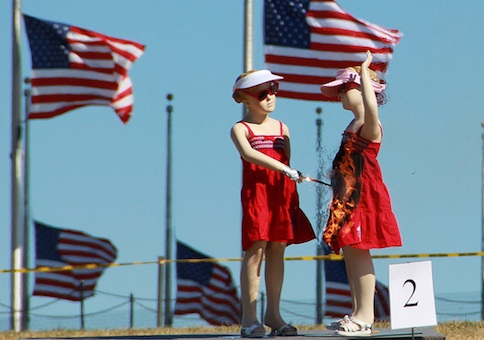This Fourth of July the federal government is issuing dire warnings to protect children from the menace of sparklers.
The Consumer Product Safety Commission (CPSC) has released intense stick figure videos and posters warning that children should never be allowed to hold a sparkler, due to fire hazards.
"Yes, we do not recommend children use sparklers, as they burn at about 2,000 degrees, which is hotter than a blow torch," Nychelle Fleming, a spokesperson for the CPSC told the Washington Free Beacon.
A 2012 video entitled "Un-Sparktacular Celebration" features a stick figure family who let their children use sparklers unsupervised.
"No! Don’t leave! They shouldn’t have that!" the video says. Moments later the girl hits her brother in the arm with her sparkler, causing his entire arm to turn red.
"Sparklers can burn at 2000 degrees Fahrenheit, as hot as a blowtorch," the video adds. "Are you giving one to your child?"
The CPSC uses the same message in a poster that shows a worker igniting a little boy’s sparkler with a blowtorch, directly next to his head.
The agency held an event at the National Mall last Thursday where they blew off the heads of dummies to show the dangers of playing with fireworks. Featured in the demonstration were several sets of young girl dummies lighting the dresses of their friends on fire with sparklers.
The CPSC defends its aggressive campaign on fireworks and sparklers due to an estimated 11,400 injuries in the United States last year, or 3.6 per 100,000 people.
According to the agency’s annual report, released earlier this month, sparklers resulted in an estimated 2,300 trips to the emergency room, and 31 percent of all firework injuries in 2013.
The report cited four cases where people were injured from sparklers, including an eight-year old boy who burned his thumb. It took him 1 to 2 days to recover.
Another incident occurred after a 24-year-old father tried to light a sparkler while holding three others in his hand, lighting his hand on fire. The man sustained second-degree burns. Two other cases involved sparks flying into two children’s eyes, though each recovered in a few days.
The report found that 58 percent of sparkler injuries involved the hands and fingers. Females were more likely to be hurt when using them.
Fleming said it is difficult to estimate the total budget for the agency’s anti-fireworks campaign. She was able to confirm that the agency spent $20,000 for a video news release that provided network television stations with b-roll of the fireworks demonstration.
"Internal staff produces the press release, fact sheet, advisory, and utilizes our wire services to get the word out to the country through media lists," Fleming said. "Also lab personnel tests fireworks throughout the year as samples come in. So it is a little difficult to give a budget as I would be afraid that it is not inclusive as we have multiple offices working on fireworks safety throughout the year."
She said the "Un-sparktacular" video was produced in house with software in the CPSC’s communications office.
